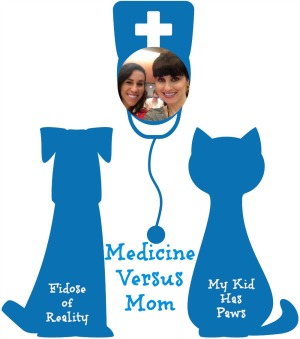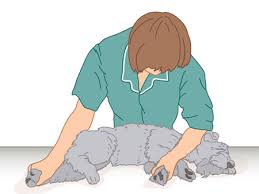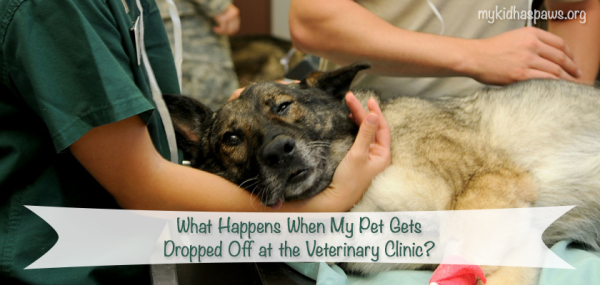
Once again, Carol Bryant from Fidose of Reality and myself, have decided to bring together our experiences in order to give you two sides to the same story. If you missed our inaugural post of Medicine versus Mom, you can check it out here.
If you aren’t familiar with Carol Bryant, she is a good friend and fellow pet blogger. She is the founder and CEO of Fidose of Reality. If you haven’t checked out her blog, you really should! As a seasoned blogger and writer she brings her dedicated pet parent perspective to share will all “Dog Lovers of the Highest Order”. Her posts are always a must read for me, and for any other pet parent out there. As we progress through our Medicine versus Mom series, I hope to share with you even more reasons why Carol is awesome!

Today we are going to discuss the most difficult subject in veterinary medicine…euthanasia.
This post is very difficult for me, as I unfortunately experienced euthanasia on a regular basis as a veterinary technician and its one of those things that ultimately made me leave. Each veterinarian and veterinary technician deals with it differently, many of us….have regular nightmares. We always remembered our patients, and losing each one weighed heavy on our hearts. Even now, as I hunch over a tear stained keyboard I remember the beautiful faces of some of my most cherished patients. That being said, I am writing this simply to help those who are seeking information, and hopefully to provide some small amount of comfort during the most difficult of times.
There is no right answer to the question, “How do I know when its time?”. Its an impossible question to answer, but I want you to know that your veterinarian and their staff may be a source of comfort and information for you.
Often people feel that they need to make the decision on their own, and they have to show up at the vet’s office with a definitive answer, but that is far from the truth. Many veterinarians are willing to schedule what we call, QOL visits. QOL standing for Quality of Life. These visits give you an opportunity to go talk to your vet, (many people don’t even bring their pet) and discuss all of the options, medical history and current quality of life.
What questions should I ask at a QOL visit?
1. Are we effectively treating the underlying cause of illness? It is important to understand that age is not a disease, therefore pets are not suffering from age, but from an underlying condition that may, or may not, be related to their age. Its important to understand the underlying cause of illness and understand all possible treatments for the specific illness. You and your veterinarian can decide together what the most effective treatment is for your pet, and then decide if the condition is worth treating.
2. Will treating the current illness improve my pet’s quality of life? Sometimes the answer is no. Many diseases require treatments whose risk outweigh the reward. If that is the case, you may decide to not treat, and to let your pet live out their life comfortably. Your vet can be a great resource in helping you answer this question.
3. Are we doing everything we can to keep my pet comfortable? Regardless of whether or not you are actively treating the underlying illness, there are options that can help keep your pet as comfortable as possible. This may include additional medications, herbs, or holistic treatments.
If you have already decided to treat, or not treat, the illness, and you are already doing everything that you can to keep your pet comfortable, and yet their condition is still worsening it may be time to start preparing yourself and your family.
I have been in the exam room when the family realizes that they need to prepare themselves, and then comes the question, “When is the right time?”. As I said before, there is no right answer to this question, but what I believe helps the most is to talk about it, and don’t be afraid to seek comfort in your veterinary staff. I have sat in exam rooms with owners and been a sounding board for their worries and fears, and we talk through the situation to ultimately come to a conclusion that everyone in the family is comfortable with.
When people ask me if their pet has a good quality of life, there are three things I try to emphasize:
1. Are they eating and drinking? Animals have a natural instinct to eat or drink. By nature, they know that they need food and water to survive. Firstly, if they have stopped eating and drinking, you want to make sure that they aren’t having a treatable medical issue that is causing this. If they don’t have a medical condition that is treatable (i.e. a terminal condition) and they have given up eating and drinking, it may be time to consider their quality of life.
2. You know them best…what are the most important things to them? For example, in 2012 my family and I said goodbye to our Rocky. We knew that Rocky was suffering from spinal compression, and it would one day stop him from going to the park, which was the thing he loved most. We knew that once Rocky was unable to make it to the park (even with a wheelchair) his quality of life was not as good as it once was, and at that time we began preparing ourselves. (Despite knowing this, all I could say to Rocky at the end was, “I’m sorry”. I felt like I had failed him. Sometimes, having all the knowledge in the world still doesn’t help….and I know that.)
3. Sometimes….they will let you know. We all have an understanding with our pets, one that can’t be seen or heard, but is real and true. Trusting in that bond that you have with your pet, and trust that they will let you know if they can. Sometimes, no matter how strong your bond, this time will never come.
I also stress to people to discuss this with the whole family. I feel that it really helps to make a decision when every one is on the same page. Making this decision is difficult, and it always hurts, so having the support of your veterinarian and your family can really help.
What can I expect from my vet and their staff?
Your veterinarian and their staff should be there to answer your questions, and help you get through this difficult time.
When we knew there was going to be a euthanasia we wanted to make sure we were prepared and professional. Firstly, we would always lay a blanket down on the ground, or the table, to make the patient feel more comfortable. We would also try to reduce noise in the hospital and would make sure there was enough tissues in the room. I know these things seem small, but being on the other side, it definitely makes a difference.
Many vets provide a sedative and give you a few moments alone with your pet. When the times comes, we always ask if you want to be in the room, each person has a personal preference and we want to make sure that everyone understands what is happening, when it is happening.
Don’t be afraid to reach out for comfort. I have hugged so many people in an exam room because I knew they needed it, and I knew how they were feeling in that moment…and I would give 1000 more hugs if I had to.
As difficult as this process is, don’t be afraid to turn to your veterinarian or their staff, we may be able to answer some of your questions and help you work through your biggest fears or worries.
I hope that no one reading this is at this point in their pet’s life. If you are, my thoughts and prayers are with you and your family, and I wish I could give you a hug.
Please visit Carol’s blog, for her Mom point of view.




